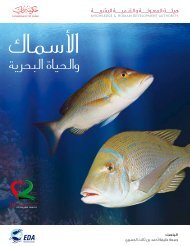EDA February 2006.indd - Emirates Diving Association
EDA February 2006.indd - Emirates Diving Association
EDA February 2006.indd - Emirates Diving Association
- No tags were found...
Create successful ePaper yourself
Turn your PDF publications into a flip-book with our unique Google optimized e-Paper software.
Based on the water temperature, a general recommendation is:Above 30ºCUse a lycra or 0.5 mm suit, this is only for sun/jelly fish protection26 – 30ºC Use a 0.5 mm suit or 2.5 mm shorty suit for a little warmth20 – 30ºC Use a 3 mm one piece suit, possibly adding a lycra suit or shorty for extra warmth15 – 24ºC Use a 5 mm one piece suit, with a lycra suit or shorty. Consider using a hoodBelow 15ºC5/7 mm semi-dry suit or dry suitThe above recommendation can only be used as a rough guideline as tolerance to cold varies from person to person. Generallyyou will need to add more protection if you are female, thin, doing several repetitive dives, low activity or decompression dives, orif you just get cold easily.THE RIGHT SUIT FOR YOUEach diver should determine what thickness or style will best fit their needs based on recommendations from instructors or localdive store professionals. If your suit is too warm, you can flood it to cool off, but, if you begin with insufficient thermal protectionall you can do is shiver or stop diving!SUIT DESIGNSMost modern wetsuits are a one piece, full length steamer style suit with a back zip. These come in a variety of thicknesses – 0.5mmfor warm water, 3mm for cooler water, 5mm for cold water.A good value option is to buy a 0.5 mm suit for the summer and a 3 mm or 5 mm for winter. When the water gets cold simplywear both suits to get extra warmth. A shorty style suit also works for the summer and can be put on top of a 3 or 5 mm steamerin the winter. However it does not offer protection on arms and legs against jelly fish.+ + = WARM HAPPY DIVER!Undersuit One Piece Wetsuit HoodIn winter if a 5 mm suit does not offer enough warmth then the way to go could be towards a dry-suit. Dry-suits will keep a diverwarm and are great for keen divers who dive repeatedly. However they are not the same to operate as a wetsuit and it is anexcellent idea to do a dry suit course before diving in the suit. Divers Down is planning to run dry-suit courses soon. Ask them fordetails about their dry suit courses. (Divers Down – Tel: 09 2370299).If the expense of a dry-suit is too much, then the easiest method to stay warm is to add a hood. A diver loses about 25% of hisbody heat from his head when immersed in water. Wearing a hood makes a huge difference between being chilled and being toastywarm on a dive. Like wearing a wetsuit for the first time, a hood feels unnatural and restricting. After a couple of warm dives youwill get used to it and welcome it.COMMON QUESTIONS ABOUT WETSUITS“I feel that I am choking across my throat when I try the suit on. Do I need a bigger size?”The answer is that you probably do not need a larger suit, even though you feel uncomfortable. Confused? Well the correct fit caneasily be checked. The neck seal may feel very tight when you are standing up in a vertical position. When you are diving you willbe in a horizontal position and the fit will be completely different. The best way to check a suit for this fitting problem is to lie facedown on the floor with your arms by your side, in the same position you are in when you dive. If the neck seal feels tight now, thenit does not fit and you do need another size or suit design. If there is no pressure on your neck now, then the suit fits. Just keep thesuit unzipped until you are ready to get into the water.“The suit hurts a bit, but it will stretch once I am in the water, right??”Ummm no. Remember – tight is good, but pain is bad. If the suit actually hurts you then it is unlikely that it will stretch enough whenyou are in the water to prevent any pain. If a tight fit means that your hands swell, or your arms hurt at the elbow or upper armthen the suit does not fit you. Ditch it and go for a better fit.The answer is that a bit of struggling when putting a suit on is generally a good sign as it means that the suit is tight and thereforewill keep you warm. There are however a couple of things you can do to make putting the suit on easier.• Wear a lycra suit or 0.5 mm neoprene suit underneath. The wetsuit will slide more easily over the undersuit than over cold,bumpy, (and maybe hairy) human skin. The undersuit also adds an extra thermal layer, keeping the diver warmer.• If conditions will allow you, put the wetsuit on in the water. The water in the suit will allow you to slide into it without anydifficulties.“My wetsuit smells, what can I do?”A small minority of divers take the extreme option of warming their suits the “natural” way. This does give a few moments ofwonderful warmth, but can result in a tell-tale smell later. Damp neoprene that has stayed wet over a couple of days (thinkof repeated use on a diving trip) can also result in bad smelling neoprene. This smell is caused by bacteria which are notalways removed by normal washing. A specialist product may be needed, such as “Sink The Stink”. This is a small capsuleof concentrated deodorising liquid which will kill all nasty, smelly bacteria and make the suit fresh and lovely again. AtDHS 5.00 a capsule or DHS 35.00 for a 4 oz bottle, it is a great stand-by product to have, or to gift to a smelly friend.Most specialist dive shops stock this.“Should I buy or rent a wetsuit?”In UAE waters a diver will normally need a wide selection of wetsuits as the water temperatures range from a high 33ºC + in July/ August and to less than 21ºC in January / <strong>February</strong>. In the summer months a suit is not needed for warmth but is needed forprotection against jelly fish stings and sunburn. If you dive extensively and live to dive, then buy every wetsuit that you will use. Thisgives you the flexibility to dive at short notice. If you cannot dive as often as you want (and in the UAE how many people get thetime to dive regularly?) then consider renting a suit for the time period that you dive least and buy a suit for the water temperaturewhen you dive most. A good guideline is:• Buy a summer wetsuit (a thin lycra suit or a 0.5 mm neoprene suit) for protection against jellyfish, coral burn, sun burn, nastyscratchy things. This is a good value buy as it will act as an undersuit later in the year.• Buy a 3mm suit or a 5mm suit if you dive enough to justify the cost, do not want to rent a wetsuit that someone else has used orsecretly fancy yourself in neoprene.• Rent a 3mm suit or 5mm suit for when the water gets cold. Renting allows flexibility regarding the wetsuit thickness (rent a 3mmin November, then a 5mm in January) and is very affordable when compared to the cost of buying a suit. Ensure that the suitsare cleaned between rentals to get rid of smells from previous users who have warmed the suit the “natural way”. Any decentdive centre or rental operation will maintain a high standard of cleanliness, especially where wetsuits are concerned.If you have problems finding a wetsuit to fit you, come to Scuba Dubai and make an appointment to see the wetsuit fittingspecialist.“IF WE CANNOT HELP YOU, THEN WE WILL FIND SOMEONE WHO CAN”SCUBA DUBAIGround floor, Block C, Trade Centre Apartments, Sheikh Zayed Road, Dubai.Showroom: 04 331 7433OPENSaturday 9 am – 8.30 pm (open through out)Sunday – Wednesday 9 am – 1 pm / 4 pm – 8.30 pmThursday 9 am – 7 pm (open through out)CLOSED FRIDAY“I am struggling to get my suit on. How can I make it easier?”10 EMIRATES DIVING ASSOCIATION, FEBRUARY 2006 FEBRUARY 2006, EMIRATES DIVING ASSOCIATION 11












